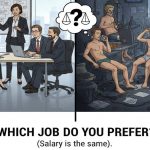2026-01-08 08:39:36

When I was younger, in my 20s, I assumed that everyone was working “hard,” meaning a solid 35 hours of work a week. Especially, say, university professors and professional engineers. I’d feel terribly guilty when I would be messing around, playing video games on a workday.
Today I realize that most people become very adept at avoiding actual work. And the people you think are working really hard are often just very good at focusing on what is externally visible. They show up to the right meetings but unashamedly avoid the hard work.
It ends up being visible to the people “who know.” Why? Because working hard is how you acquire actual expertise. And lack of actual expertise ends up being visible… but only to those who have the relevant expertise.
And the effect compounds. The difference between someone who has honed their skills for 20 years and someone who has merely showed up to the right meetings becomes enormous. And so, we end up with huge competency gaps between people who are in their 30s, 40s, 50s. It becomes night and day.
2026-01-07 08:47:23

2026-01-01 22:03:25

We are experiencing one of the most significant technological breakthroughs of the last few decades. Call it what you will: AI, generative AI, large language models…
But where does it come from? Academics will tell you that it stems from decades of mathematical efforts on campus. But think about it: if this were the best model to explain what happened, where would the current breakthroughs have occurred? They would have happened on campus first, then propagated to industry. That’s the linear model of innovation—a rather indefensible one.
Technology is culture. Technological progress does not follow a path from the blackboard of a middle-aged MIT professor to your desk, via a corporation.
So what is the cultural background? Of course, there is hacker culture and the way hackers won a culture war in the 1980s by becoming cool enough to have a seat at the table.
But closer to us… I believe there are two main roots. The first is gaming. Gamers wanted photorealistic, high-performance games. They built powerful machines capable of solving linear algebra problems at very high speeds.
Powerful computing alone, however, does you no good if you want to build an AI. That’s where web culture came in. Everything was networked, published, republished. Web nerds helped build the greatest library the world had ever seen.
These two cultures came together to generate the current revolution.
If you like my model, I submit that it has a few interesting consequences. The most immediate one is that if you want to understand how and where technological progress happens, you have to look at cultural drivers—not at what professors at MIT are publishing.
2025-12-31 23:26:25

Culture wars are real. They occur when a dominant culture faces a serious challenge. But unless you pay close attention, you might miss them entirely. As a kid, I was a “nerd.” I read a lot and spent hours on my computer. I devoured science and technology magazines. I taught myself programming. “Great!” you might think. Not at all. This was not valued where and when I grew up. Computers were seen as toys. A kid who spent a lot of time on a computer was viewed as obsessed with a rather dull plaything. We had a computer club, but it was essentially a gathering of “social rejects.” No one looked up to us. Working with computers carried no prestige. Dungeons & Dragons was outright “dangerous”—you had to hide any interest in such games. The 1983 movie WarGames stands out precisely because the computer-obsessed kid gets the girl and saves the world. Bill Gates was becoming famous around that time, but this marked only the beginning of a decade-long culture war in which hacker culture gradually rose to dominance.
Today, most people can speak the language of hackers. It did not have to turn out this way, and it did not unfold identically everywhere. The status of hacker culture is high in the United States, but it remains lower in many other places even now. Even so, in many organizations today, even in the United States, the « computer people » are stored in the basement. We do not let them out too often. They are not « people persons ». So the culture war was won by the hackers, the victory is undeniable. But as with all wars, the result is more nuanced that one might think. Many would like nothing more than to send back the computer people at the bottom of the prestige ladder.
Salaries are a good indicator for prestige. In the USA, in Australia and in Switzerland, « computer people » have high salaries and relatively high status. In the UK as a whole? Not so much. I bet you do better as a « financial analyst » over there.
What is worth watching is the effect that « AI » will have on the status battles. In some sense, building software that can do financial, political and legal analysis is the latest weapon in the arsenal of the computer people. Many despair about what AI might do to software developers: I recommend looking at it in the context of the hacker culture war.
2025-12-31 03:15:55

How much virtual memory does the following C++ expression allocate on the heap?
new char[4096]
The answer is at least 4 kibibytes but surely more.
Firstly, each heap memory allocation requires some memory to keep track of what has been allocated. You are likely using 8 bytes or so of overhead that your program cannot access.
Secondly, the memory allocator may allocate a bit more than the 4096 bytes you requested. On a Linux machine, I found that it would allocate 4104 bytes, so 8 extra bytes that are usable by your program. You can check this value by calling malloc_usable_size under Linux.
Thus, overall, you may end up with an extra 16 bytes allocated when you requested 4096 bytes. It is an overhead of about 0.4%. You are basically wasting a byte for every 256 bytes that you allocate.
But that is not the worst possible case. On macOS, let us consider the following line of code.
new char[3585]
The system reports an allocation of 4096 bytes: a 14% overhead. What is happening is that macOS rounds up the memory allocation to the nearest 512 byte boundary for moderately small allocations. If you try allocating even larger memory blocks, it starts rounding up even more.
2025-12-29 22:41:00

Many people say that they crave more freedom.
But what do we mean by “freedom”?
Being free from constraints? Is that what we mean? Would you feel “freer” if you could walk outside in your underwear?
It is almost surely not what you mean by “freedom.”
I submit to you that it is almost always the case that if you are frustrated at work by your lack of freedom, the actual problem is competence.
Imagine two scenarios.
Assuming that the salary is the same, which job do you prefer?
I cannot answer for you, but most people I know prefer Scenario A.